Intel Rocket Lake (14nm) Review: Core i9-11900K, Core i7-11700K, and Core i5-11600K
by Dr. Ian Cutress on March 30, 2021 10:03 AM EST- Posted in
- CPUs
- Intel
- LGA1200
- 11th Gen
- Rocket Lake
- Z590
- B560
- Core i9-11900K
Motherboards
All of these new processors are LGA1200 processors, and a result they will be enabled in 500-series motherboards. There is also some 400-series support, however it depends on the platform. Here’s the trusty AnandTech Guide for support:
| Motherboard Support | |||
| AnandTech | B460 H410 |
Z490 Q470 H470 |
Z590 B560 H510 |
| Comet Lake | Yes | Yes | Yes |
| Rocket Lake | No | Yes | Yes |
The reason why Rocket Lake will not work in H410 or B460 motherboards is because these chipsets are built on Intel’s older 22nm process. There is something in the design of those chipsets, likely to be related to signal integrity, which means they cannot be supported, at least at the PCIe 3.0 speeds required. Given previous motherboard firmware, we might see unofficial support later down the line, even if only in PCIe 2.0 mode.
However, the lead platform for Rocket Lake will be the Z590 platform. The new features boil down to:
- Double CPU-to-Chipset bandwidth when paired with 11th Gen RKL
- USB 3.2 Gen 2x2 (20 Gbps) native chipset connectivity
The new H570 and B560 motherboards reintroduce memory overclocking, a feature that was removed from the 400-series budget motherboards.
Here is the slide Intel provided for 500-series, though it is worth mentioning some of the caveats:
In this slide, it states that discrete Wi-Fi, 2.5 gigabit Ethernet, and Thunderbolt 4 are supported on 500 series. These are optional upgrades for the motherboard vendors, so not all motherboards will have them, and in each case they also require additional hardware costs for the motherboard manufacturer, such as an RF module for Wi-Fi, a PHY for Ethernet, or a PHY for Thunderbolt. These could all be added to any other motherboard, AMD or Intel, with discrete controllers which are slightly more expensive – those controllers don’t have to be Intel either. But to be clear, they are not unique to offerings to Z590, nor are they natively offered by default on all systems.
All of the 10th Generation Comet Lake processors will work in all 500-series motherboards, and get all the features, except the double CPU-to-Chipset bandwidth, as that specifically requires Z590 + 11th Gen Core CPU.
It should be noted that anyone already with a 400-series or 500-series motherboard, or those looking to purchase one, will need a BIOS update in order to enable the latest performance enhancements. In our testing, we found that the BIOS on our boards when they arrived in our offices were quite old (from January), and the latest microcode from Intel should help increase performance and cache latency. Some may be updated to February microcode, which does get most of the way there to peak performance, but the latest should always give the best results.
Intel Z590 and B560
The two main chipsets to focus on for Rocket Lake are the Z590 and B560 motherboards. The Z590 start at an eye-watering $175 and go up to over $1000, whereas the B560 are more palatable starting from $75 up to around $220.
Where the B560 and Z590 differ is in some of the PCIe bifurcation (x16 only on B560), the number of USB ports, and the chipset number of PCIe 3.0 lanes available for M.2 or additional controllers.
| Intel 500-Series Chipset | |||
| Feature | B560 | Z590 | Z490 |
| Socket | LGA1200 | LGA1200 | LGA1200 |
| PCIe Lanes (CPU) | 20 | 20 | 16 |
| PCIe Specification (CPU) | 4.0 | 4.0 | 3.0* |
| PCIe Config | x16 x16/+4 |
x16 x8/x8 x8/x8/x4+4 |
x16 x8/x8 x8/x8/+4 |
| DMI Lanes (3.0) | x4 | x8 (RKL) x4 (CML) |
x4 |
| Chipset PCIe 3.0 Lanes | 12 | 24 | 24 |
| Max USB 3.2 (Gen2/Gen1) | 4/6 | 6/10 | 6/10 |
| USB 3.2 Gen 2x2 (20 Gbps) | Y | Y | ASMedia |
| Total USB | 12 | 14 | 14 |
| Max SATA Ports | 6 | 6 | 6 |
| Memory Channels (Dual) | 2/2 | 2/2 | 2/2 |
| Intel Optane Memory Support | Y | Y | Y |
| Intel Rapid Storage Technology (RST) | Y | Y | Y |
| Integrated WiFi MAC | Wi-Fi 6 | Wi-Fi 6 | Wi-Fi 6 |
| Intel Smart Sound | Y | Y | Y |
| Overclocking Support | *Memory | Y | Y |
| Intel vPro | N | N | N |
| Max HSIO Lanes | ? | ? | 30 |
| ME Firmware | 15 | 15 | 14 |
| TDP (W) | 6 | 6 | 6 |
We’ve gone through all 90+ motherboards from both chipsets, and collated them into two large overviews:
- The Intel Z590 Motherboard Overview (50+ Models)
- The Intel B560 Motherboard Overview (40+ Models)
These are all the details on all the motherboards we’ve been able to identify as coming to market. Note that not all will be available in every region, with some being OEM/customer specific and might only be available on the OEM market.
By and large, we have observed several key metrics worth discussing with the new motherboards.
First is the large uptake of 2.5 gigabit Ethernet. It has taken literal years since the first consumer 2.5 GbE solutions came to market with Aquantia, and they were limited to select motherboards at a premium price point. Now we are seeing Intel and Realtek-based 2.5 GbE controllers make their way down to something more affordable. More and more NAS and routers are coming with one or more 2.5 GbE ports as standard, and as more systems get enabled with higher speed for wired connectivity, we should see the market open up a lot more. It won’t improve your internet speed, but it might improve home streaming with the right network configuration.
The other element these boards bring is USB 3.2 Gen 2x2 (20 Gbps). This is the double speed ‘USB 3.2’ standard that was renamed, and now we get this feature native on 500-series chipsets. It was only previously possible with additional ASMedia controllers, but now Intel motherboards can have them, but only if the motherboard vendor enables it. We’re seeing mostly front-panel connections adhere to this standard, but a few motherboards have it available as a Type-C connection on the rear panel.
Also of note is that the B560 motherboards are now enabling memory overclocking again, which was removed in B460. Any 10th Gen or 11th Gen processor in a B560 can have overclocked memory. CPU overclocking is still limited to the Z-series motherboards.
Overclocking Enhancements For Memory: Ratios
On the Overclocking Enhancement side of things, this is perhaps where it gets a bit nuanced. For a while now Intel has been binning its K processors to within an inch of their maximum supported frequencies, and turbo boost techniques like favored core and Thermal Velocity Boost also push the margins on the cores that support it. So what can Intel focus on for overclocking this time round?
With Rocket Lake, Intel is leaning into the memory side of things. These new Rocket Lake processors now support geared ratios between the memory controller and the DRAM data rates. Users can either select a 1:1 ratio or a 2:1 ratio.
Traditionally Intel has natively operated on a 1:1 ratio without ever giving users the option. This meant that in order to push that DDR4-5000 memory, like we did in our review of that premium Corsair kit, it required a processor with a good memory controller that could also support a 5.0 GT/s connection.
With the 2:1 ratio, the memory controller will now operate at half speed, in a more comfortable zone, allowing memory overclockers to go beyond traditional limits. With that DDR4-5000 memory, it means that the memory controller is now only operating at 2.5 GT/s (1250 MHz because DDR4 is measured in transfers per second, and there are two transfers per clock in Double Data Rate DDR memory). This also means that in order to match the internal clocks on DDR4-3200, users will have to start pushing the memory itself to DDR4-6400 to get the memory controller back on a level footing when in that 2:1 ratio. Nevertheless, this feature does allow the memory to be tested to its limits without the bottleneck of the CPU.
By default, all Rocket Lake processors will support DDR4-2933 at a 1:1 ratio in the specifications. Above this will mean a 2:1 ratio, except for the Core i9 family, which allows for a DDR4-3200 1:1 ratio. Despite these specifications, every motherboard we tested puts DDR4-3200 on a 1:1 ratio for all CPUs, so the delineation between the Core i9 and the rest seems arbitrary.
Overclocking Enhancements For Memory: Dual POST
Users that have tried memory overclocking will note that in order to change the memory ratio, it requires a restart. With the new Z590 system, Intel has devised a system that will let a user select two different memory ratios, and it will enable both at boot time.
Under this mode, once in the operating system, a user can switch between them for different benchmarking modes. What this does is allow extreme overclockers, particularly those going for world records with sub-zero coolants, to boot at the lower memory speed, then run the test at a higher memory speed, then instantly revert back to the slow speed. Currently they have to run at the high speed all the time, which can be liable to instability. It’s more one for the extreme overclockers, but Intel has added it here.
Other Overclocking Enhancements
Other new features in the overclocking toolkit include AVX-512 offsets and voltage guard bands, enabling users to overclock the processors without overclocking AVX-512 and incurring a heavy power consumption penalty. Intel has also put in an option to disable AVX altogether, which means that users who don’t want to worry about AVX-512 draining almost 300 W from an errantly loaded program, it can be disabled directly in the firmware.
Intel is also continuing support for a number of overclock-related features, such as per-core HyperThreading, per-core frequency adjustment, and fine-grained PLL controls. Intel has stated that with Rocket Lake, it has opened up some of the features to enable proper BCLK overclocking again, however we wait to see if there is a good range for overclockers to play with.
All these new features are enabled when a 500-series motherboard and a new Rocket Lake 11th Generation Core processor. Support with Comet Lake will be limited.


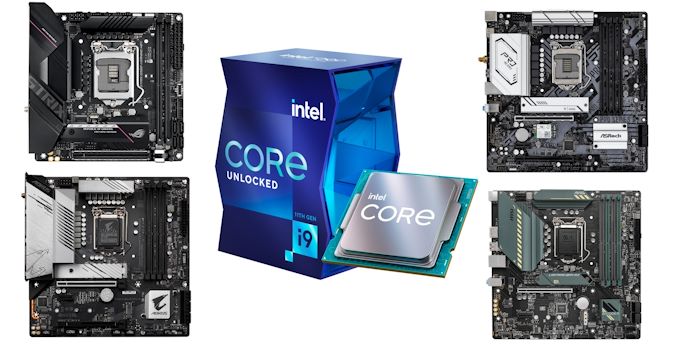
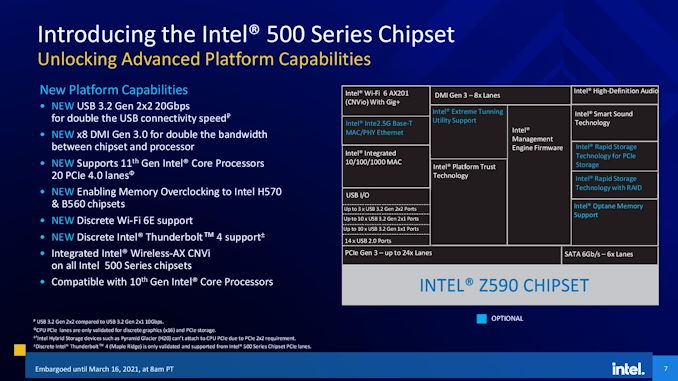
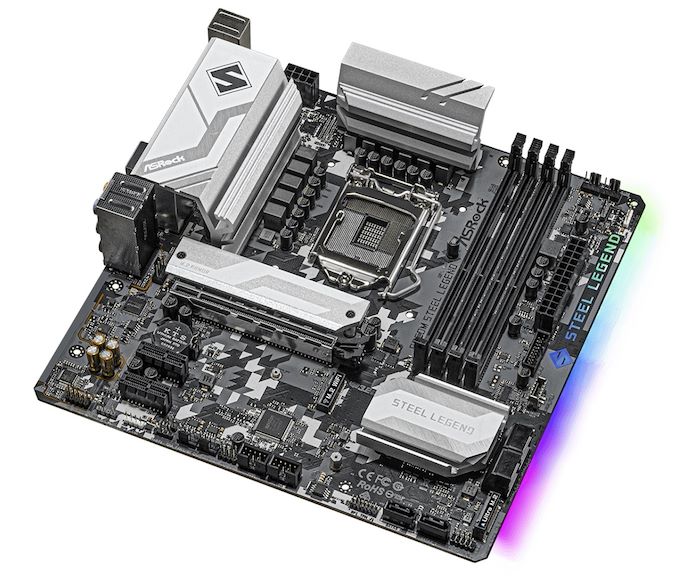
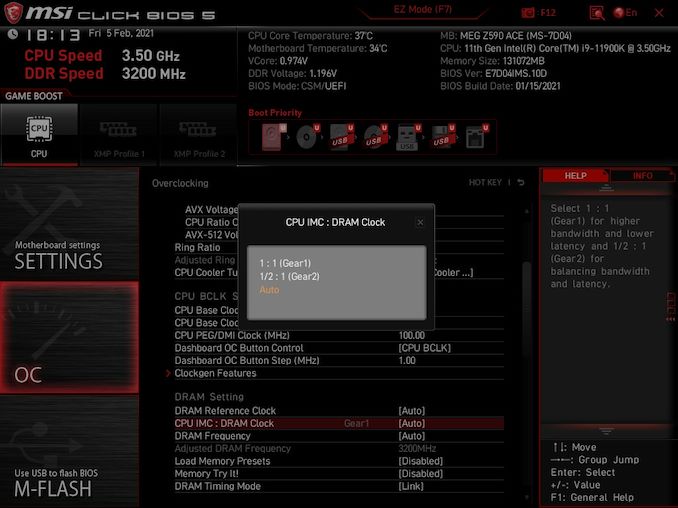
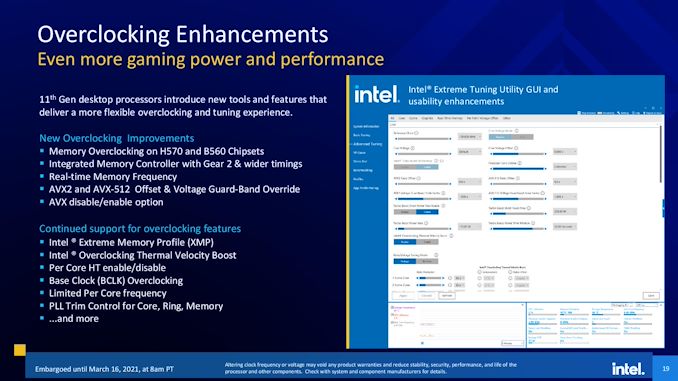








279 Comments
View All Comments
Makste - Tuesday, April 6, 2021 - link
I again have to agree with you on this. Especially with the cooler scenario, it is not easy to spot the detail, but you have managed to bring it to the surface. Rocket Lake is not a good upgrade option now that I look at it.Oxford Guy - Wednesday, March 31, 2021 - link
(Sorry I messed up and forgot quotation marks in the previous post. 1st, 3rd, and 5th paragraphs are quotes from the article.)you wrote:
‘Rocket Lake on 14nm: The Best of a Bad Situation’
I fixed it:
Rocket Lake on 14nm: Intel's Obsolete Node Produces Inferior CPU'
‘Intel is promoting that the new Cypress Cove core offers ‘up to a +19%’ instruction per clock (IPC) generational improvement over the cores used in Comet Lake, which are higher frequency variants of Skylake from 2015.’
What is the performance per watt? What is the performance per decibel? How do those compare with AMD? Performance includes performance per watt and per decibel, whether Intel likes that or not.
‘Designing a mass-production silicon layout requires balancing overall die size with expected yields, expected retail costs, required profit margins, and final product performance. Intel could easily make a 20+ core processor with these Cypress Cove cores, however the die size would be too large to be economical, and perhaps the power consumption when all the cores are loaded would necessitate a severe reduction in frequency to keep the power under control. To that end, Intel finalised its design on eight cores.’
Translation: Intel wanted to maximize margin by feeding us the ‘overclocked few cores’ design paradigm, the same thing AMD did with Radeon VII. It’s a cynical strategy when one has an inferior design. Just like Radeon VII, these run hot, loud, and underperform. AMD banked on enough people irrationally wanting to buy from ‘team red’ to sell those, while its real focus was on peddling Polaris forever™ + consoles in the GPU space. Plus, AMD sells to miners with designs like that one.
‘Intel has stated that in the future it will have cores designed for multiple process nodes at the same time, and so given Rocket Lake’s efficiency at the high frequencies, doesn’t this mean the experiment has failed? I say no, because it teaches Intel a lot in how it designs its silicon’
This is bad spin. This is not an experimental project. This is product being massed produced to be sold to consumers.
Oxford Guy - Wednesday, March 31, 2021 - link
One thing many are missing, with all the debate about AVX-512, is the AVX-2 performance per watt/decibel problem:'The rated TDP is 125 W, although we saw 160 W during a regular load, 225 W peaks with an AVX2 rendering load, and 292 W peak power with an AVX-512 compute load'
Only 225 watts? How much power does AMD's stuff use with equivalent work completion speed?
Hifihedgehog - Thursday, April 1, 2021 - link
"The spin also includes the testing, using a really loud high-CFM CPU cooler in the Intel and a different quieter one on the AMD."Keep whining... You'll eventually tire out.
https://i.imgur.com/HZVC03T.png
https://i.imgflip.com/53vqce.jpg
Makste - Tuesday, April 6, 2021 - link
Isn't it too much for you to keep posting the same thing over and over?Oxford Guy - Wednesday, March 31, 2021 - link
Overclocking support page still doesn’t mention that Intel recently discontinued the overclocking warranty, something that was available since Sandy Bridge or something. Why the continued silence on this?‘On the Overclocking Enhancement side of things, this is perhaps where it gets a bit nuanced.’
How is it an ‘enhancement’ when the chips are already system-melting hot? There isn't much that's nuanced about Intel’s sudden elimination of the overclocking warranty.
‘Overall, it’s a performance plus. It makes sense for the users that can also manage the thermals. AMD caught a wind with the feature when it moved to TSMC’s 7nm. I have a feeling that Intel will have to shift to a new manufacturing node to get the best out of ABT’
It also helps when people use extremely loud very high CFM coolers for their tests. Intel pioneered the giant hidden fridge but deafness-inducing air cooling is another option.
How much performance will buyers find in the various hearing aids they'll be in the market for? There aren't any good treatments for tinnitus, btw. That's a benefit one gets for life.
‘Intel uses one published value for sustained performance, and an unpublished ‘recommended’ value for turbo performance, the latter of which is routinely ignored by motherboard manufacturers.’
It’s also routinely ignored by Intel since it peddles its deceptive TDP.
‘This is showing the full test, and we can see that the higher performance Intel processors do get the job done quicker. However, the AMD Ryzen 7 processor is still the lowest power of them all, and finishes the quickest. By our estimates, the AMD processor is twice as efficient as the Core i9 in this test.’
Is that with the super-loud very high CFM cooler on the Intel and the smaller weaker Noctua on the AMD? If so, how about a noise comparison? Performance per decibel?
‘The cooler we’re using on this test is arguably the best air cooling on the market – a 1.8 kilogram full copper ThermalRight Ultra Extreme, paired with a 170 CFM high static pressure fan from Silverstone.’
The same publication that kneecapped AMD’s Zen 1 and Zen 2 but refusing to enable XMP for RAM on the very dubious claim that most enthusiasts don’t enter BIOS to switch it on. Most people are going to have that big loud cooler? Does Intel bundle it? Does it provide a coupon? Does the manual say you need cooler from a specific list?
BushLin - Wednesday, March 31, 2021 - link
I won't argue with the rest of your assessment but given these CPUs are essentially factory overclocked close to their limits, the only people who'd benefit from an overclocking warranty are probably a handful of benchmark freaks doing suicide runs on LN2.Oxford Guy - Thursday, April 1, 2021 - link
That’s why I said the word ‘enhancement’ seems questionable.Oxford Guy - Wednesday, March 31, 2021 - link
‘Anyone wanting a new GPU has to actively pay attention to stock levels, or drive to a local store for when a delivery arrives.’You forgot the ‘pay the scalper price at retail’ part. MSI, for instance, was the first to raise its prices across the board to Ebay scalper prices and is now threatening to raise them again.
‘In a time where we have limited GPUs available, I can very much see users going all out on the CPU/memory side of the equation, perhaps spending a bit extra on the CPU, while they wait for the graphics market to come back into play. After all, who really wants to pay $1300 for an RTX 3070 right now?’
• That is the worst possible way to deal with planned obsolescence.
14nm is already obsolete. Now, you’re adding in wating for a very long time to get a GPU, making your already obsolete CPU really obsolete by the time you can get one. If you’re waiting for reasonable prices for GPUs you’re looking at, what, more than a year of waiting?
‘Intel’s Rocket Lake as a backported processor design has worked’
No. It’s a failure. The only reasons Intel will be able to sell it is because AMD is production-constrained and because there isn’t enough competition in the x86 space to force AMD to cut the pricing of the 5000 line.
Intel also cynically hobbled the CPU by starving it of cores to increase profit for itself, banking that people will buy it anyway. It’s the desktop equivalent of Radeon VII. Small die + way too high clock to ‘compensate’ + too-high price = banking on consumer foolishness to sell them (or mining, in the case of AMD). AVX-512 isn’t really going to sell these like mining sold the Radeon VII.
‘However, with the GPU market being so terrible, users could jump an extra $100 and get 50% more AMD cores.’
No mention of power consumption, heat, and noise. Just ‘cores’ and price tag.
Oxford Guy - Wednesday, March 31, 2021 - link
'Intel could easily make a 20+ core processor with these Cypress Cove cores, however the die size would be too large to be economical'Citation needed.
And, economical for Intel or the customer?
Besides, going from 8 cores to 20+ is using hyperbole to distract from the facts.
'and perhaps the power consumption when all the cores are loaded would necessitate a severe reduction in frequency to keep the power under control.'
The few cores + excessive clocks to 'compensate' strategy is a purely cynical one. It always causes inferior performance per watt. It always causes more noise.
So, Intel is not only trying to feed us its very obsolete 14nm node, it's trying to do it in the most cynical manner it can: by trying to use 8 cores as the equivalent of what it used to peddle exclusively for the desktop market: quads.
It thinks it can keep its big margins up by segmenting this much, hoping people will be fooled into thinking the bad performance per watt from too-high clocks is just because of 14nm — not because it's cranking too few cores too high to save itself a few bucks.
Intel could offer more cores and implement as turbo with a gaming mode that would keep power under control for gaming while maximizing performance. The extra cores would presumably be able to do more work for the watts by keeping clocks/voltage more within the optimal range.
But no... it would rather give people the illusion of a gaming-optimized part ('8 cores ought to be enough for anyone') when it's only optimized for its margin.